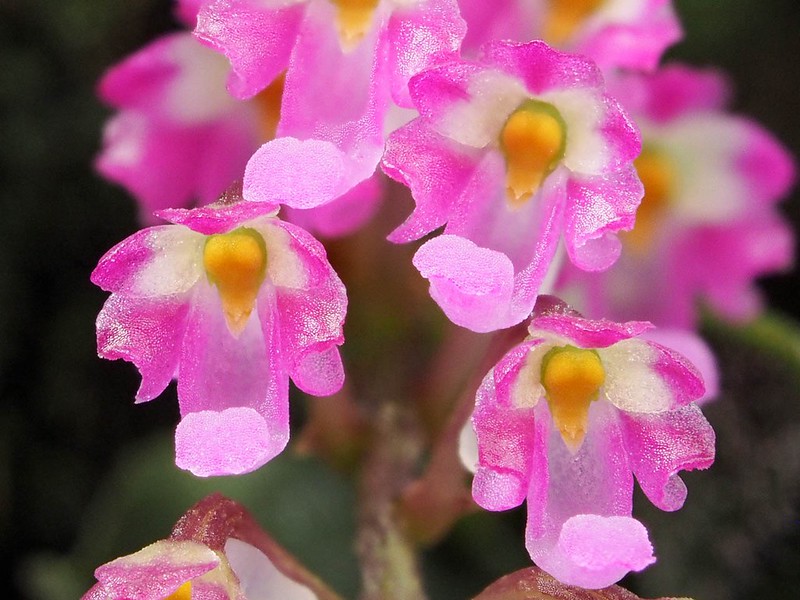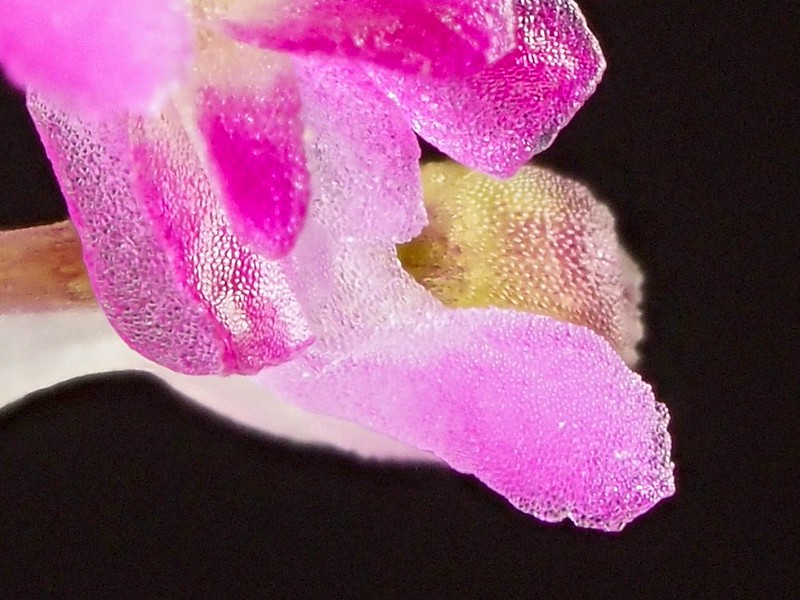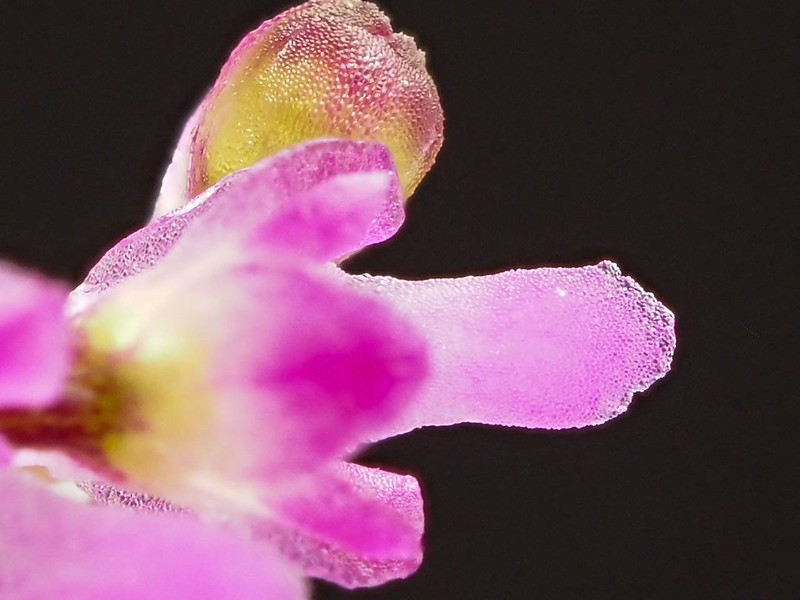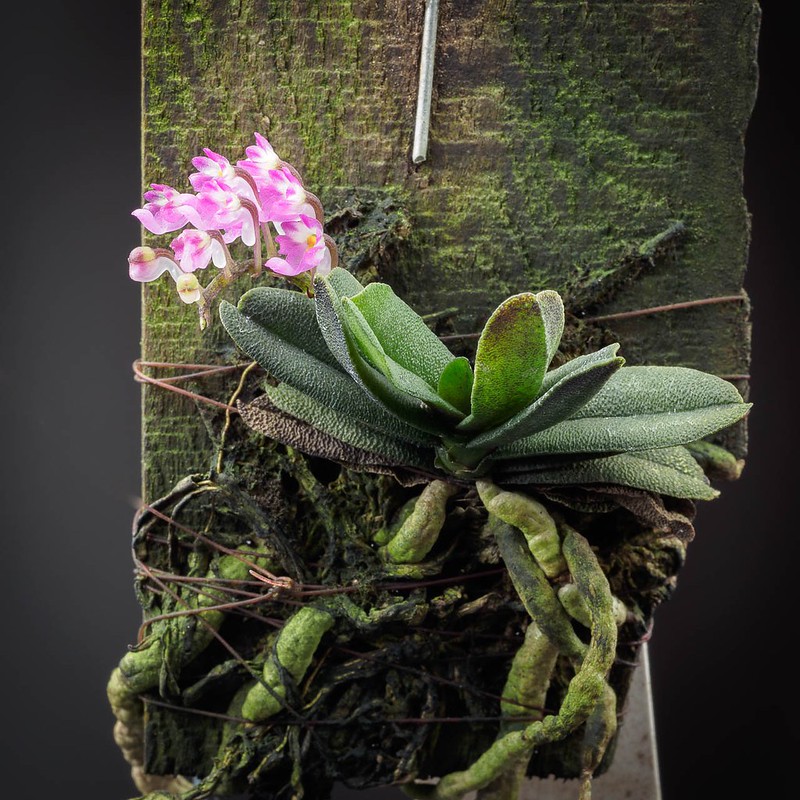
Schoenorchis tixieri is from 900 -1400m from S. Yunnan and Vietnam (Xinqi and Wood 2009). I was told that mine is Chinese origin, so mine might be from S. Yunnan, but I don't know the detailed history. From looking at the flower of my plants with 10x loupe, I can't tell the difference from S. fragrans. Unfortunately, I killed my S. fragrans, and I didn't take photos when it flowered, so I have been gazing photos in Flickr and from google image search. I should mention that there are lots of misidentified S. seidenfadenii labelled as S. fragrans. These two species are relatively easy to tell if you look at the callus shape and the angle of the spur. Seidenfaden (1988, p.66-69) discussed the difference, and here is the key to differentiate them:
- Epichile of lip with two low rounded calli besides each other, separated by a cleft. Spur in obtuse angle to epichile .... S. seidenfadenii
- Epichile with a single large semi globular callus. Spur in a right angle to epichile, ... S. fragrans
 |
| Difference between Schoenorchis fragrans and S. seidenfadenii |
Now let's go back to the main topic of S. tixieri vs S. fragrans. Since I couldn't see the relevant difference in photos, I looked for some literature comparing S. fragrans and S. tixieri. The best I could find was Seidenfaden (1998, p.69), who briefly mentioned his observation based on the type specimen of S. tixieri from Dalat. He hadn't seen any other specimens of S. tixieri, so he did not make any conclusion about the synonymy of S. tixieri. The type specimen of S. tixieri differs from S. fragrns in the callosities (calluses) on the lip and the protruding upwards bent tridentate (3-toothed) front edge of the operculum (anther cap). Xinqi and Wood (2009) also mentions tridentate anther cap of S. tixieri.
I'm guessing this 3 teeth of the anther cap is referring to the bottom edge of the yellow anther cap extention part, which you can see in the following photo. At the tip of the column, the yellow part has a semi-spherical part, which contains two pollinia, Below the semi-spherical part, the yellow part extends down, and the extension is laid on top of the lip. The bottom of the extension shows 3 points.
 |
| Pay attention to the bottom side of the yellow anther cap. 3-teeth are laid on the lip. |
When we check the artificial key of Seidenfaden (1988, p.66-69), the shape of the anther cap is used to distinguish S. fragrans and S. seidenfadenii from S. pachyacris. For the former, he said "Front edge of operculumn (anther cap) obtuse truncate. Obtuse means an angle between 90-180 degree, so this fits Marni's S. fragrans. For S. pachyacris, he said "Front edge of operculum bilobulate", so it has two lobes/points.
With regard to the calluse shape on the lip, I'm not completely sure. S. seidenfadenii has two smaller humps, and S. fragrans has one larger hump as discussed above. S. tixieri callus and lip shape seems to be similar to S. fragrans, and it seems to have one hump (see the photo below). But when I look at the hump from a right angle, there appears to be shallow groove in the middle of the hump, which make it looks like almost 2-humped. For example, look at the photo above, which is looking at the flower from the front. You can see the lip calus is slighly like Rolling Stone's tong or McDonald's logo. S. fragrans is a relatively wide spread species from E. India, Myanmar, Thailand, and Yunan. There appears to be some variation in the lip shape within S. fragrans.
 |
| lip calluse profile view. |
 |
| Lip shape from the top |
Averyanov (2012) mentioned that he didn't find any essential differences between S. fragrans and S. tixieri to justify the separate species status. However, it is not clear if he has examined the type specimen since it was not included in the list of herbarium specimen he examined. Additionally, in his later publication, he seems to use S. tixieri (Averyanov et al. 2016), so I'm not sure about his interpretation. I'm still trying to learn about this group, so I'll try to update this post once I learn more.
Later, I found more information in a more recent paper, which describes a new related species, S. phitamii, from Southern Vietnam (Averyanov 2017). The paper contains an artificial key as well as photographic comparison of related species. In addtion to the difference in the shape of anther cap described above, he mentioned two additional differences between S. fragrans and S. tixieri. S. fragrans has dense inflorescence with relatively short lip (< twice length of a sepal or petal). S. tixieri has less dense inflorescence, and the lips is longer than 2x the length of a sepal/petal. I can kind of see these two additional differences in comparsison of my and Marni's plants. So apparently, he changed his opinion, and he is recognizing S. tixieri and S. fragrans as two distinct species.
The morphological differences between S. tixieri and S. fragrans seem small, and S. tixieri might be a north eastern variety of S. fragrans. Although morphology may be convenient to distinguish species, biologists know that morphological divergence is not the only criteria to delimit species. We probably need to get better data such as population genetic data, examining the pattern of gene flow, and/or ecological study of how the difference in the shape of anther cap might influence the pollination success to fully evaluate the species status of S. tixieri.

S. tixieri is supposed to flower in May (Xinqi and Wood 2009). I think 2 of 3 individuals I have flowered in May, and one individual is flowering in Fall (I'm not sure if this individual flowered in the spring or not). I've had them for a couple years, but I haven't paid enough attention to them, so I didn't record the blooming time, or looked at the flowers in detail until now. But I have seen several photos of S. tixieri posted in forum recently, so blooming season may not completely follow the natural schedule.
I'm growing it at the cool end of intermediate; min/max temperature of 13/24C (55/75F) most of the time. But in the hottest part of summer, it reaches 18/29C (65/85F). It probably would do better warmer, though. I used to water every day, but recently I'm watering every other day (year long). It is getting moderate amount of light (probably about 120 µmol m-2 s-1).
Original description of Schoenorchis tixieri:
S. tixieri was described by Par A. Guillaumin in 1958 as Saccolabium tixieri. Following is the excerpt from p. 462. It is interesting that he compared it to Trichoglottis trifler (=Saccolabium triflorum), which doesn't resemble to this species at all.
335. Saccolabium Tixieri Guillaum. sp. nov.
Herba 2cm alta, acaulis; follis circa 10, distichis, linearibus (1,5-2 cm x 0.5 cm) apice inaequaliter obtusis, basi haud attenuatis, crassis, subtus primum purpureis, mox viridescentibus, subtus carinatis, supra leviter canaliculatis, in utraque pagina leviter rugosis. Inflorescentia ad basin lateralis, racemosa, circa 10-flora, 1,5 cm longa, sepalo superiore ovato, 1 mm longo, sepalis lateralibus oblique fere quadratis, 2 mm longis, petalis ellipticis, apice attenuatis, 1 mm longis, ut sepalis basi viridibus, apicem versus roseie, labello 4 mm longo, 3-lobato, lobis lateralibus late ovatis, albis, margine roseis, medio lineari, apice crasso papillosoque, roseo, calcare albo, curvato, pendulo, 2 mmm longo, apice subgloboso, columna fere o, antherae operculo luteo, dimidio superiore ovato, medio plicato et basi minute 3-dendato, polliniis 2, caudiculo longo, recto, glandula anguste lanceolata, ovario pedicelloque indistincto calcare longiore.
Peut se confondre avec Saccolabium triflorum Guillaum. mais feuilles carénées en dessous et peu profondément canaliculées en dessus ; l'inflorescnece est plus florifére et le labelle est différent par ses lobes non triangulaire, le médian épaissi à son extrémité en une sorte de globe applati.
Extra: Original description of Schoenorchis fragrans:
S. fragrans was described by H. G. Reichenbach in 1874 as Saccolabium fragrans. The publication is available here. The OCR was screwed up there, so I manually corrected it. Here is the exact excerpt:
Saccolabium fragrans, Par. & Rchb. f.; valde humile, foliis brevissimis lingulatis apice subacutis obliquis inæqualibus, siccis rugosissimis, racemis decurvis plurifloris pluribus, bracteis triangulis ovaria pedicellata infima dimidio æquantibus, sepalis petalisque ligulatis obtuse acutiusculis, labello elongato trifido, laciniis lateralibus semiquadratis hinc repandulis, obtusangulis, lacinia media euneata apice rhombea acuta medio callosa, callo parvo inter lacinias laterales, calcari angulato apice inflato obtuso ovarium pedicellatum plus dimidio æquante, columnæ basi utrinque angulata.
Our plant is a small thing; no wonder it was overlooked. The roots are flexuose, furrowed and very large for such a dwarf, scarcely half an inch high. The leaves reach the length of one iach; there appear to have been seven on the specimen (four fallen off) ; five are represented in the Rev. C. Parish's nice sketch. They are entirely covered with flexuose transverse wrinkles, which look very pretty under a lens. The inflorescences are bent down and bear as many as fifteen flowers, as minute as those of S. pusillum. The sketch shows the stalked ovary green with the middle part whitish-rosy; the sepals green at the base, the rest purplish like the whole petals and lip; spur light whitish-rose. The smell is like that of violets according to the discoverer, who collected it May 14, 1873. We may compare it with the following species: S. brevifolium, Lindl., is a tall, caulescent plant, and differs widely in its flowers, especially in the spur. S. pusillum (Œceoclades pusilla, Lindl.) has a much longer and very acute spur, and S. gracile, Lindl., has the spur much longer and straight. These are the only species which need comparison.
Literature cited:
- Averyanov, L. V. 2012. New orchid taxa and records in the flora of Vietnam (越南植物誌蘭科之新分類群與新紀錄種). Taiwania, 57(2): 127-152.
- Averyanov, L.V., Nguyen, K.S., Maisak, T.V., Konstantinov, E., Nguyen, T.H. and Bounphanmy, S., 2016. New and rare orchids (Orchidaceae) in the flora of Cambodia and Laos. Turczaninowia, 19(3): 5-58.
- Averyanov, L.V., Nguyen, V.C., Nong, V.D., Maisak, T.V. 2017. Schoenorchis phitamii spec. nov. Aver., eine neue, dekorative Miniaturorchidee aus Südvietnam (Schoenorchis phitamii spec. nov. Aver., a new ornamental miniature orchid species from Southern Vietnam). Die Orchidee 3(4): 21-32. (PDF)
- Guillaumin, P. A. 1958. Plantes nouvelles, rares ou critiques des serres du Muséum (Notules sur quelques Orchidées d'Indochine, XIX). Bulletin du Muséum National d'Histoire Naturelle 30 (5): 458-463.
- Reichenbach, H. G. 1874. Contributions to Orchidology - I. New Orchids discovered by the Rev. C. Parish, at Moulmein. The Journal of Botany, British and Foreign 12: 196-199
- Seidenfaden, G., 1988. Orchid genera in Thailand: 14. Fifty-nine vandoid genera. Opera Botanica, 95: 1-398.
- Xinqi, C. and J. J. Wood 2009. 156. Schoenorchis Blume, Bijdr. 361. 1825. Flora of China 25: 452-453. (link to PDF)

Naoki, I just love this stuff you keep posting. I love your detailed breakdown with all the excellent information. We had someone bring a S. tixieri (From Andys) in bloom to our last Orchid Society Meeting. Having seen just how small that plant is give me an amazing amount of respect for the photos you are taking. Amazing work!
ReplyDeleteThank you! But in reality, I'm completely relying on the feature of Olympus E-M1. Without its automatic focus stacking, it would be much more tedious to take the photo of flowers which are only 2-3mm wide!
DeleteAmazing work....very detail......excellent descriptions....
ReplyDeleteThank you for the comment, Kang!
Deleteis it possible for me to download your description above. i am writing a private book about orchids. it is NOT for a commercial purpose...i am just orchids lover. i will try to translate it into bahasa as best as i could. i live in BALI-INDONESIA.
Deletei bought two compot S. tixieri three days ago....and i love her very much. that why i search any info about her. i hope someday she will has a baby(keiki)...;)
DeleteThank you. All contents and photos of non-human subjects are licensed under Creative Commons Attribution SharesAlike 4.0 (CC-BY-SA-4.0). So you can use it freely (even for a commercial use) as long as you follow the rule.
Deleteok than.....thank you very much...i realy appreciate that.....thank you
ReplyDelete